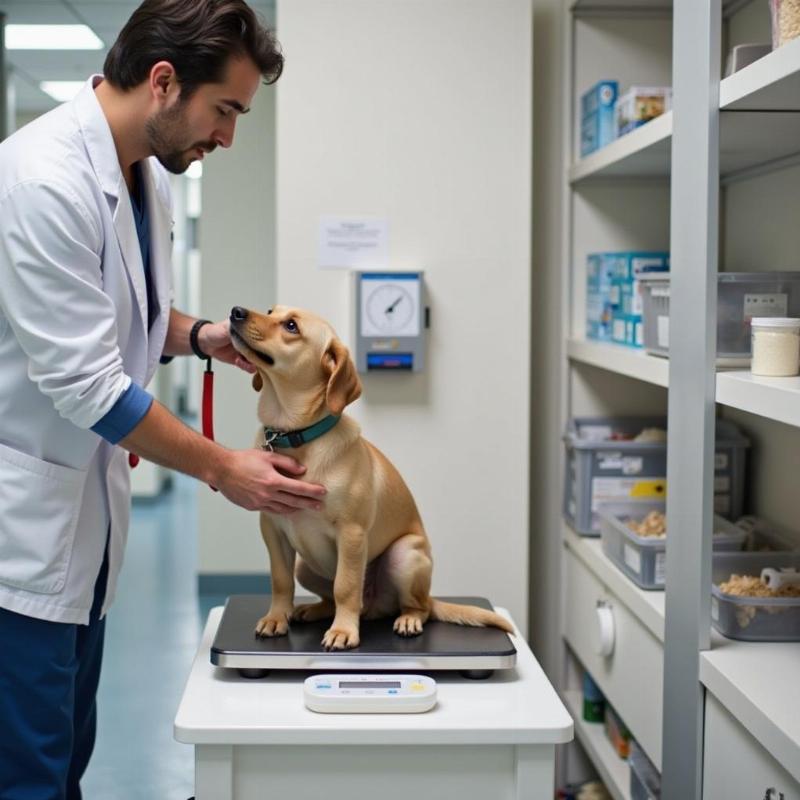Cushing syndrome, also known as hyperadrenocorticism, is a common endocrine disorder in dogs, particularly affecting older dogs. This condition occurs due to the overproduction of cortisol, a vital hormone for various bodily functions. A crucial aspect of managing Cushing syndrome in dogs involves a specific cushing syndrome diet for dogs, designed to support their overall health and mitigate the effects of the disease. This guide will delve into the importance of a cushing syndrome diet for dogs, providing practical advice and valuable insights for pet owners in the United States.
Understanding the Need for a Cushing Syndrome Diet for Dogs
Cushing syndrome presents a range of symptoms, including increased thirst and urination, increased appetite, weight gain, panting, hair loss, and a pot-bellied appearance. These symptoms can significantly impact a dog’s quality of life, and dietary management plays a vital role in alleviating these issues. By carefully controlling a dog’s nutrient intake, we can minimize the adverse effects of excessive cortisol and support their overall well-being.
A specialized cushing syndrome diet for dogs typically focuses on controlling calorie intake to manage weight gain, limiting sodium to reduce water retention and high blood pressure, and providing easily digestible proteins to support muscle maintenance. natural treatment for sards in dogs
Key Dietary Considerations for Dogs with Cushing Syndrome
Protein: The Building Block
High-quality, easily digestible protein sources are crucial for dogs with Cushing syndrome, as they help maintain muscle mass, which can be compromised by the disease. Opt for lean protein sources like chicken breast, turkey, fish, and eggs.
Fat: The Energy Source
Moderate fat intake is essential for providing energy and supporting healthy skin and coat. Healthy fats, like those found in fish oil and flaxseed oil, can also have anti-inflammatory properties.
Carbohydrates: The Fuel
Complex carbohydrates, such as brown rice, sweet potatoes, and oatmeal, provide a steady source of energy and fiber, which aids in digestion and can help regulate blood sugar levels. Avoid simple carbohydrates like white rice and processed treats.
Sodium: The Silent Culprit
Restricting sodium intake is crucial for dogs with Cushing syndrome, as excess sodium can worsen fluid retention and contribute to high blood pressure, common complications of the disease.
Creating a Cushing Syndrome Diet Plan
Consult your veterinarian to develop a personalized cushing syndrome diet plan tailored to your dog’s specific needs and health status. They can assess your dog’s condition, recommend appropriate portion sizes, and monitor their progress.
Home-cooked vs. Commercial Diets
Both home-cooked and commercial diets can be suitable for dogs with Cushing syndrome. Home-cooked meals allow for complete control over ingredients but require careful planning and balancing of nutrients. Commercial diets formulated for Cushing syndrome offer convenience and ensure balanced nutrition. why do old dogs pant so much
“When preparing home-cooked meals for a dog with Cushing syndrome, it’s crucial to work closely with a veterinary nutritionist to ensure the diet meets all the dog’s nutritional requirements,” advises Dr. Emily Carter, DVM, a board-certified veterinary nutritionist.
Monitoring and Adjustments
Regular monitoring of your dog’s weight, appetite, thirst, and urination is essential to assess the effectiveness of the cushing syndrome diet. Your veterinarian may need to adjust the diet based on your dog’s response to treatment and any changes in their condition.  Checking Dog's Weight
Checking Dog's Weight
Conclusion
A cushing syndrome diet for dogs is a crucial component of managing this complex endocrine disorder. By providing a balanced and tailored diet, we can minimize the symptoms, improve quality of life, and support the overall health of dogs diagnosed with Cushing syndrome. Consult with your veterinarian for personalized guidance and monitoring. why do old dogs pace
FAQ
- What are the first signs of Cushing’s disease in a dog? Increased thirst and urination, increased appetite, and weight gain are often the first noticeable signs.
- Can Cushing’s disease be cured in dogs? While not always curable, Cushing’s disease can be managed effectively with medication and diet.
- What should I avoid feeding my dog with Cushing’s? High-sodium foods, sugary treats, and excessive amounts of simple carbohydrates should be avoided.
- How long can a dog live with Cushing’s disease? With proper management, dogs with Cushing’s can live for several years after diagnosis.
- Are there any natural remedies for Cushing’s disease in dogs? While some natural remedies may be suggested, always consult your veterinarian before trying any alternative treatments. treatment for sards in dogs
- Is a special diet always necessary for dogs with Cushing’s? A specialized diet is often recommended to manage the symptoms and complications of the disease.
- How often should I monitor my dog’s weight while on a Cushing’s diet? Regular monitoring, as recommended by your veterinarian, is essential, often initially weekly or bi-weekly.
Related Articles
Beautdogs.us is your premier online resource for all things dog-related in the United States. We offer expert advice on dog breeds, care, and products, catering to both new and experienced dog owners. From breed-specific guides to health and nutrition tips, Beautdogs.us is your trusted source for comprehensive and engaging canine information. Contact us for expert advice and personalized support at [email protected] or call us at +1 501-555-7529. Beautdogs.us is dedicated to helping you provide the best possible care for your beloved companion.